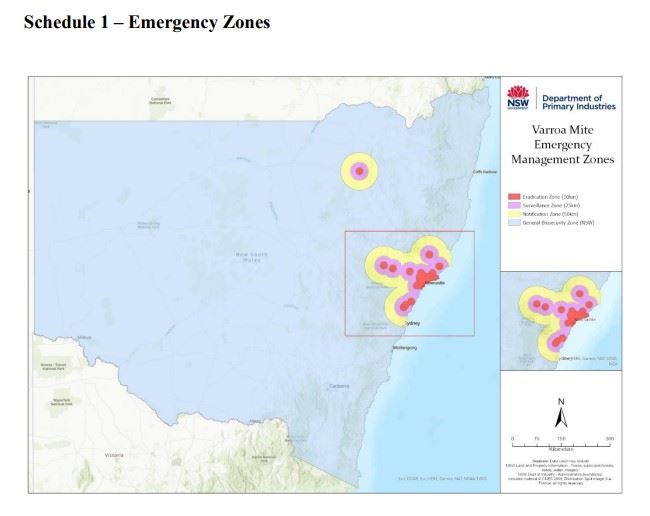 Please find below, the updated NSW DPI Biosecurity (Varroa Mite) Emergency Order No.14 issued by the Deputy Plant Protection Officer of NSW.
Please find below, the updated NSW DPI Biosecurity (Varroa Mite) Emergency Order No.14 issued by the Deputy Plant Protection Officer of NSW.
I have taken the following update (posted yesterday evening 17/07/2022) from the NSW DPI website.
A new Biosecurity Order has been made available, including one new infested premises detected. The infested premises is located east of Singleton, within the existing Hunter area emergency zones.
The order includes the following changes:
- the Varroa Mite Response map has been updated online at www.dpi.nsw.gov.au/varroa
- the definition of rendered wax has been updated to exclude straining. Commercially, the process may not include straining. As varroa mites will not survive in temperatures above 50 degrees Celsius and wax melts between 62.5 and 65 degrees Celsius, the rendering process kills varroa mites. Consequently, there is no biosecurity risk posed by rendered beeswax.
Industry and DPI working together
DPI continues to work closely with industry representatives in response the Varroa mite emergency in the Hunter area.
DPI and industry representatives want to assure both commercial and recreational beekeepers that their concerns are being heard and addressed as surveillance continues as a priority across the Hunter. DPI and NSW bee industry representatives continue to work together during this emergency response.
Preparing for NSW registered commercial beekeepers to move hives
As included in this newsletter yesterday, later this week registered commercial beekeepers will be able to apply to move hives enabling business continuity for the honeybee industry and support for crops that require pollination services.
The registered commercial beekeepers must be located within NSW outside of the eradication, surveillance or notification zones (red, purple and yellow zones).
Beekeepers can start to prepare by:
- Alcohol washing a proportion of their hives and recording the results to prove they are free from Varroa mite.
- Checking their records are up to date and that none of their hives have been in an eradication, notification or surveillance zone within the past 24 months.
The number of hives that need to be sampled with an alcohol wash will depend on how many hives are to be moved
- Less than 640 hives requires 64 hives to be sampled
- 640 hives or more require 10% of the hives being moving to be sampled.
More information on the permit, including answers to frequently asked questions will be provided through the week.
As a final note, I have placed the updated NSW DPI Varroa Mite map at the bottom of this email. Should you wish to access the interactive version of the online map, please click here.
Kind regards,
Jo Martin
QBA State Secretary

